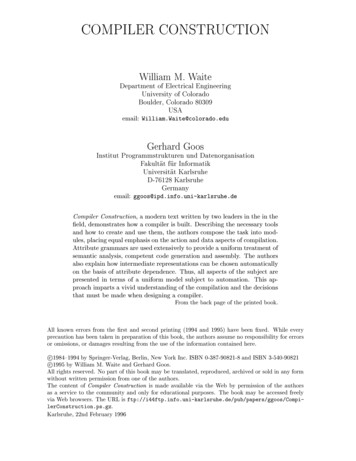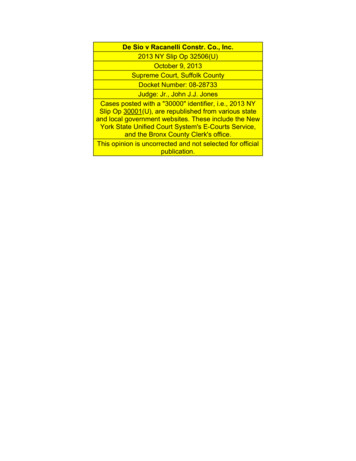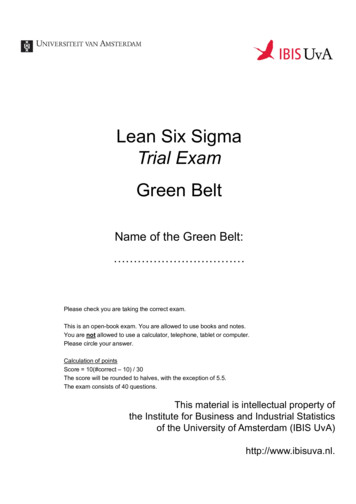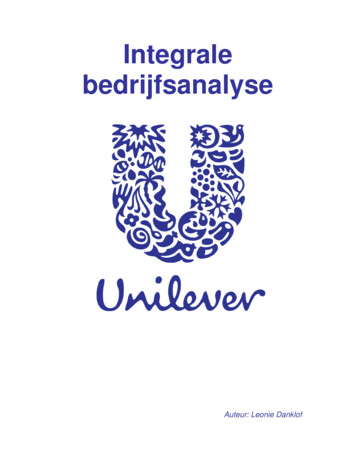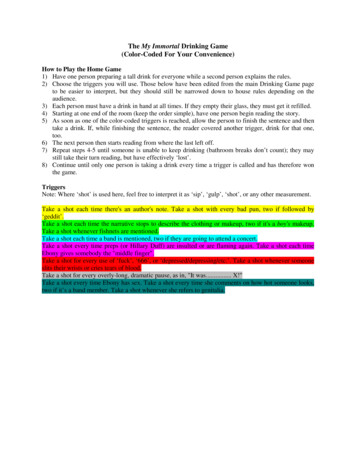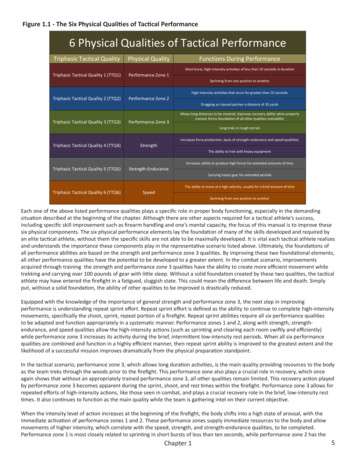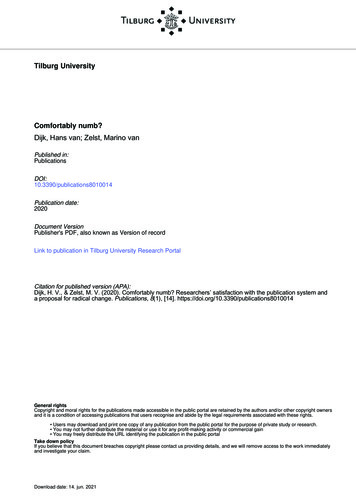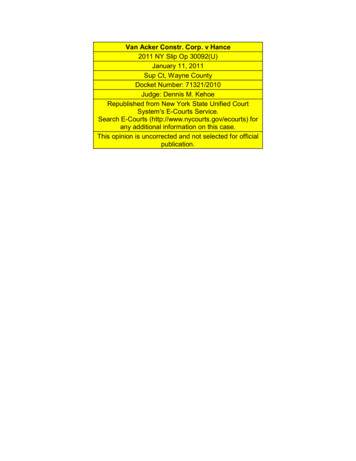
Transcription
Van Acker Constr. Corp. v Hance2011 NY Slip Op 30092(U)January 11, 2011Sup Ct, Wayne CountyDocket Number: 71321/2010Judge: Dennis M. KehoeRepublished from New York State Unified CourtSystem's E-Courts Service.Search E-Courts (http://www.nycourts.gov/ecourts) forany additional information on this case.This opinion is uncorrected and not selected for officialpublication.
[* 1]STATE OF NEW YORKSUPREME COURTCOUNTY OF WAYNEVAN ACKER CONSTRUCTION CORPORATIONPlaintiff,-vsNANETTE HANCE,DefendantDECISIONIndex No. 713214OfOGoldberg Segalla, LLPChristopher J. Belter, Esq., of CounselDaniel B. Moar, Esq., of CounselAttorneys for PlaintiffLacy Katzen, LLPJohn T. Refermat, Esq., of CounselAttorney for DefendantThe Plaintiff has moved for an Order pursuant to the New York Rulesof Professional Conduct (22NYCRR 1200.0) disqualifying the firm of LacyKatzen, LLP from serving as the Defendant's legal counsel in the instantaction.The Defendant has opposed the motion, maintaining that there isno need for the disqualification.The Plaintiffs claim arises from a verbal agreement between thePlaintiff and the Defendant, pursuant to which the Defendant engaged thePlaintiff in February 2009 to perform improvements to her residence locatedat 7710 Hamilton Street, Williamson (Pultneyville), New York.-1-In the
[* 2]Complaint, the Plaintiff alleges that it furnished materials and servicesrelated to the project totaling 137,040.79. The Plaintiff further maintainsthat, in response to a series of invoices presented to Defendant, theDefendant paid only the sum of Ei6,454.73, leaving an alleged balance dueof 70,586.06. The Plaintiff filed a Mechanics Lien against the property onMarch 26, 2010.Subsequently, the Plaintiff commenced this action toforeclose the lien by filing a Summons and Complaint on July 22, 2010,which also sets forth cause of action based on breach of contract, accountstated and unjust enrichment. The Defendant served an Answer andCounterclaim, setting forth numerous affirmative defenses, as well as nineCounterclaims.This motion arises from the Plaintiffs claim that Susan VanAcker, asPresident of the Plaintiff Corporation, spoke with a member of the LacyKatzen firm on the telephone in late April or early May 2010, regardingpossible representation by the firrn in connection with the Plaintiffs claimagainst the Defendant. Specifically, Ms. VanAcker spoke to Peter Rodgers,Esq., in a telephone conversation, during which she alleges that theydiscussed possible causes of action, as well as potential settlement figures.Ultimately, the Plaintiff chose not to hire Lacy Katzen and retained Goldberg-2-
[* 3]Segulla, LLP, which commenced this lawsuit on the Plaintiffs behalf.However, prior to the commencement of the action, the Defendantreceived correspondence dated May 19, 2010 from Christopher J. Belter,Esq., of the Goldberg firm, demanding payment by the Defendant of thebalance allegedly due to the Plaintiff. In response to the letter, Mr. Belterreceived a telephone call in June 2010 from John T. Refermat, Esq., of LacyKatzen, to discuss possible resolution of the matter. Upon relaying thesubstance of the conversation to Mrs. VanAcker, she expressed surprise toMr. Refermat as to Lacy Katzen's involvement in the matter, due to her priordiscussion regarding the case with Mr. Rodgers. An exchange of emailssubsequently took place regarding representation of the Defendant, butLacy Katzen determined that no conflict existed and declined to withdraw.Pleadings were exchanged, and this motion ensued.The Plaintiff relies on Rule '1.18 of the Rules of Professional Conduct,which states in part as follows:(a) A person who discusses with a lawyer the possibility offorming a client-lawyer relationship with respect to a matter is a"prospective client".(b) Even when no client-lawyer relationship ensues, a lawyerwho has had discussions with a prospective client shall not use-3-
[* 4]or reveal information learned in the consultation, except as Rule1.9 would permit with respeGt to information of a former client.(c) A lawyer subject to parawaph (b) shall not represent a clientwith interests materially advl rse to those of a prospective clientin the same or a substantially related matter if the lawyerreceived information from the prospective client that could besignificantly harmful to that person in the matter, except asprovided in paragraph (d). If a lawyer is disqualified fromrepresentation under this paragraph, no lawyer in a firm withwhich that lawyer is associated may knowingly undertake orcontinue representation in such a matter, except as provided inparagraph (d).Pursuant to this Rule, the fact that the Plaintiff did not formally retain LacyKatzen to represent her is clearly not determinative of the issue. (See, e.g.Burton v Burton, 139 AD2d 554 (2" Dept, 1988)). The rule extends to "apreliminary consultation by a prospective client with a view toward retentionof the lawyer, even where actual employment does not arise." (The RoseOcko Foundation, Inc. v Liebovitz, 155 AD2d 426 (2" Dept, 1989)).There are a number of inconsistencies in the respective accounts ofthe telephone conversation which admittedly took place between Mrs.VanAcker and Mr. Rodgers, including issues as to length and contents. In-4-
[* 5]his affidavit, Mr. Rodgers maintains that the conversation was brief, and thatthere was little discussion regarding the details of the case. However, Mrs.VanAcker alleges that the call lasted 18 minutes, that they outlined potentialclaims against the Defendant and that they discussed specifics as to theamount of money needed to settle the case. Counsel for the Defendantdenies that anyone possesses any knowledge regarding potential settlementfigures, and that Lacy Katzen has received no information from Mrs.VanAcker which could prove "significantly harmful" to her, as required byRPC §1.18(c).The courts have recognized that "a party's entitlement to berepresented in ongoing litigation by counsel of his own choosing is a valuedright which should not be abridged absent a clear showing thatdisqualification is warranted." (HHim v Merritt-Meridian Corp., 236 AD2d367,2"' Dept, 1997) (citations omitted)). However, this entitlement must bebalanced against a party's right to be free from apprehension that his or herinterests will be prejudiced as a consequence of any prior conversationsbetween counsel and the opposing party (See, e.g. Oeshiens v Ford MotorCo., 81 AD2d 707 (3" Dept, 1981)).The Court has no doubt that Lacy Katzen undertook the-5-
[* 6]representation of the Defendant in good faith and that considerable time andeffort has already been expended by them in this matter. However,"It is axiomatic that an attorney must avoid even the appearance of a conflictof interest." (Bridges v A/can Constr. Corp, 134 AD2d 316 (2" Dept, 1987)).As the Court of Appeals has observed," with rare and conditionalexceptions, the lawyer may not place himself in a position where aconflicting interest may, even inadvertently, affect, or give the appearance ofaffecting, the obligations of the professional" (Matter of Kellv 23 NY2d 368).It is a settled principle that "doubts as to the existence of a conflict of interestmust be resolved in favor of disqualification so as to avoid even theappearance of impropriety". (Seely v Seely, 129 AD2d 625 (2" Dept,1987))Therefore, the Court finds that disqualification is appropriate, given thetotality of circumstances, and the Plaintiff's motion is granted.Counsel for the Plaintiff is directed to submit an Order in accordancewith this Decision.Dated:January 11, 2011Lyons, New YorkHonorable Denni M. KehoeActing Supreme Court JusticeZS: I d III NVr ll.-6-
Attorneys for Plaintiff Lacy Katzen, LLP John T. Refermat, Esq., of Counsel Attorney for Defendant DECISION Index No. 71321 4OfO The Plaintiff has moved for an Order pursuant to the New York Rules of Professional Conduct (22NYCRR 1200.0) disqualifying the firm of Lacy Katzen, LLP from servin
